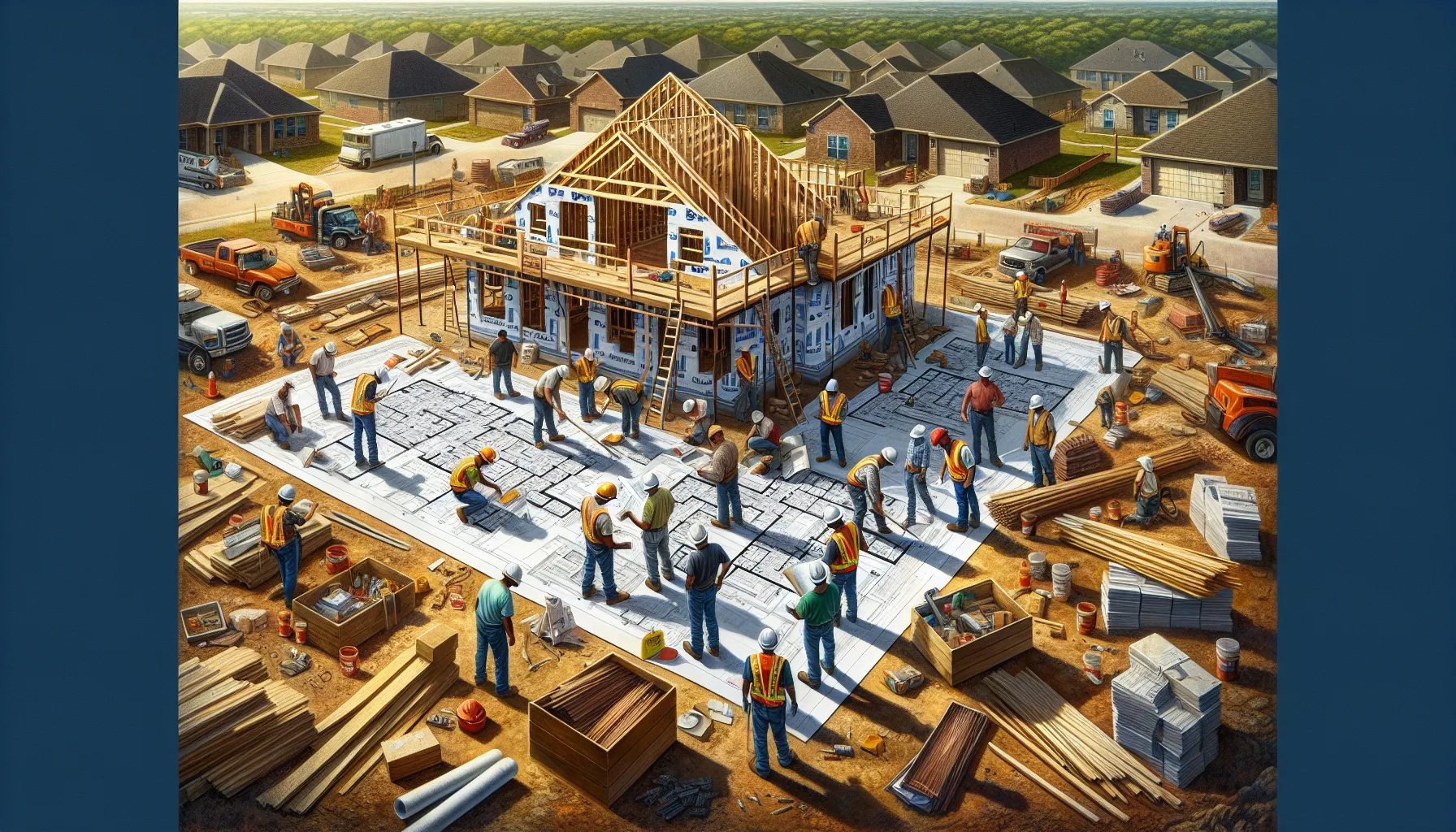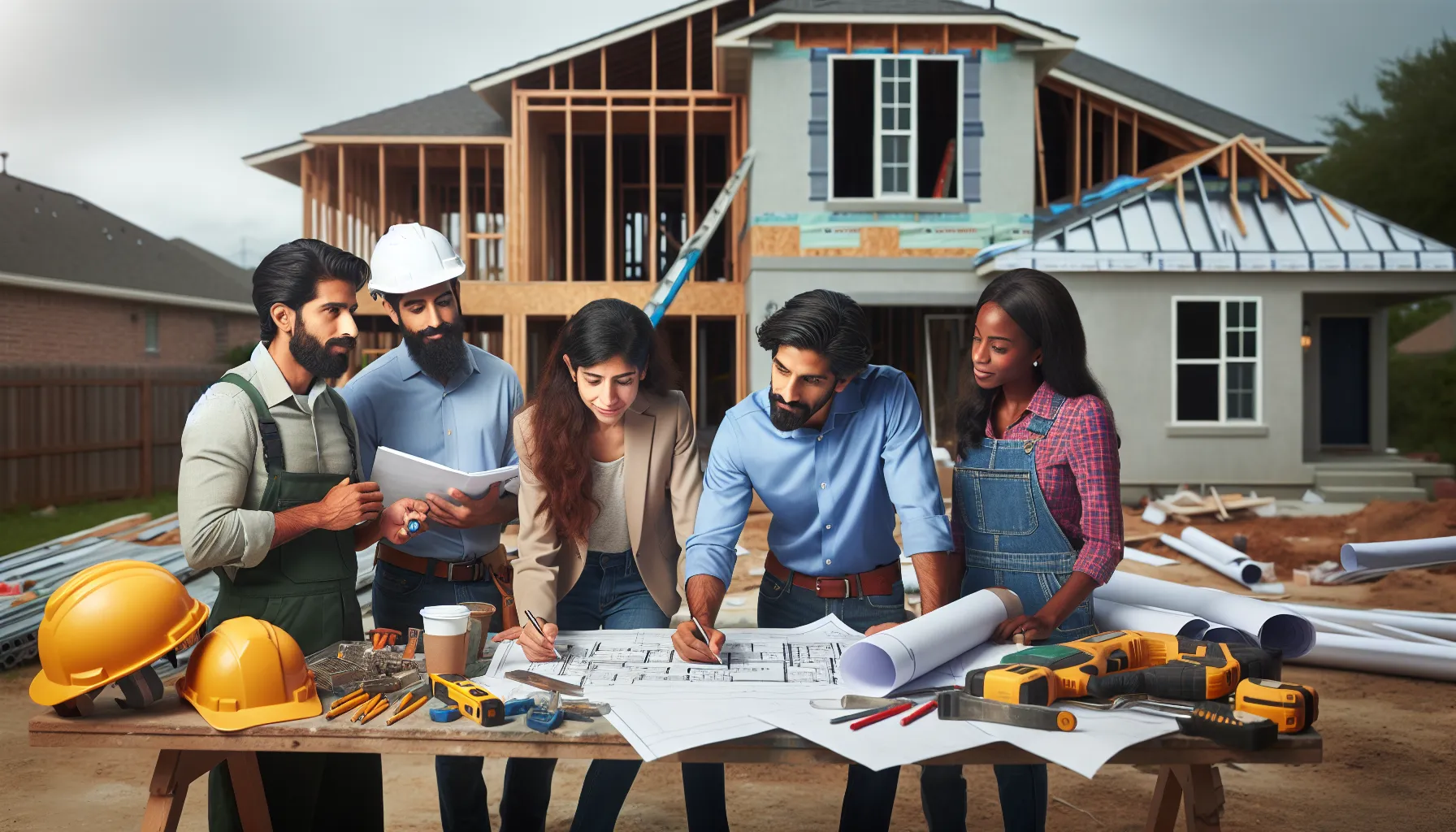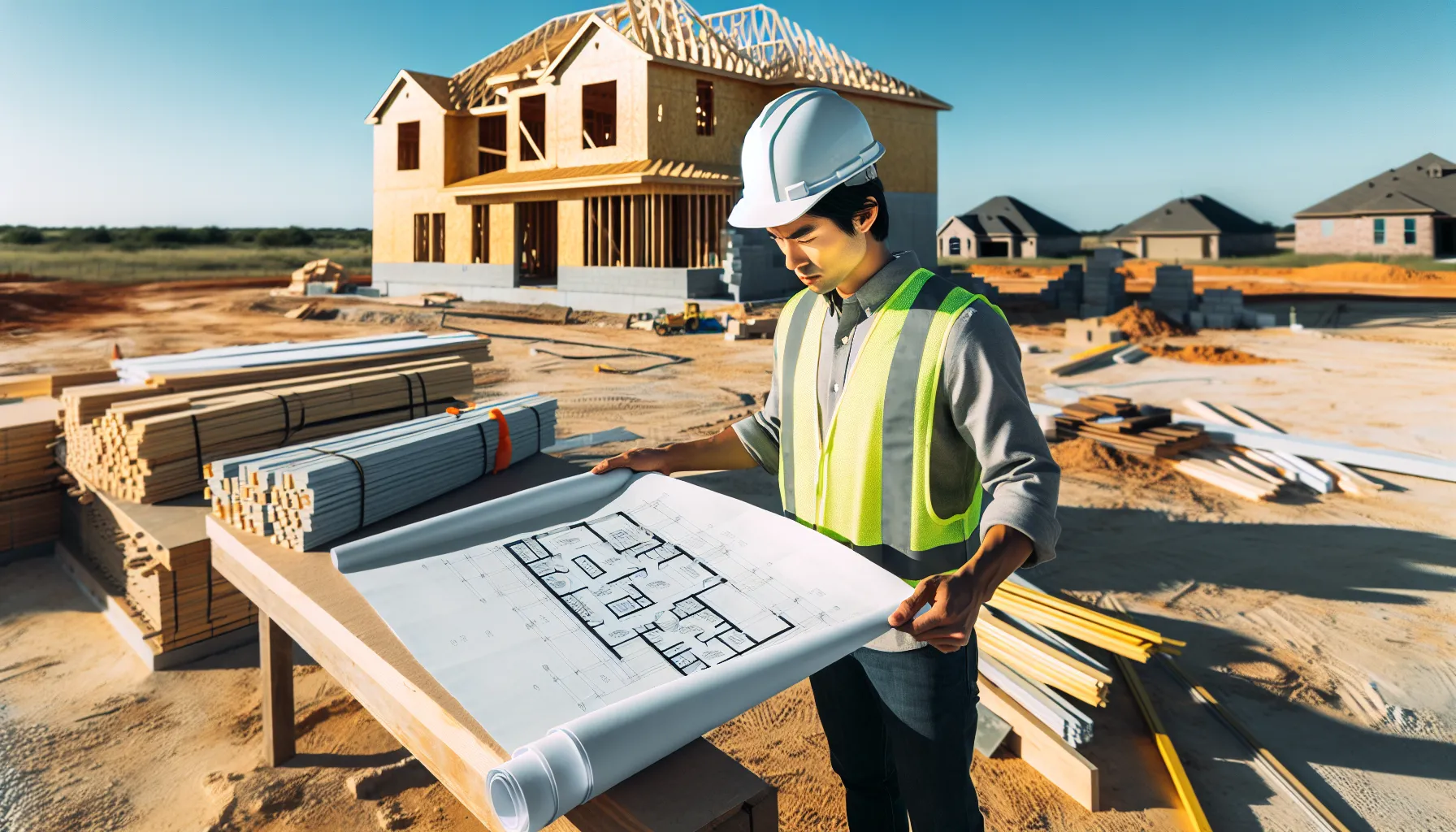Key Takeaways
- Average Cost Ranges: Building a home in Texas typically costs between $100 to $200 per square foot for standard homes, with custom builds potentially reaching $400 per square foot.
- Location Matters: Urban areas like Austin and Dallas experience higher building costs due to increased demand and land prices, influencing overall budget management.
- Material Selection: Choosing standard materials can save 20% to 30% compared to high-end options, significantly impacting the overall cost of construction.
- Labor Costs Variability: Skilled labor rates in Texas range from $20 to $50 per hour, varying by region, which affects total expenses and budgeting for the home-building process.
- Permitting Fees: Building permits and inspection fees can vary from $1,000 to $5,000, making it crucial to factor these costs into the overall budget to avoid unexpected delays.
- Comparative Value: Texas offers more affordable building costs compared to states like California and New York, making it a viable option for prospective homebuyers seeking value for their investment.
Building a house in Texas is an exciting adventure, but it comes with a lot of questions—especially about costs. As we dive into the average expenses involved, it’s important to understand the factors that influence these numbers, from location to materials and labor. Texas, with its diverse landscapes and booming population, offers a unique real estate market that can impact your budget significantly.
Have you ever wondered how much it really costs to build your dream home in the Lone Star State? We’ll explore the average costs, breaking down each component to give you a clear picture. Whether you’re planning a cozy cottage or a sprawling estate, knowing what to expect can help us make informed decisions and avoid surprises along the way. Let’s navigate this journey together and uncover the true cost of building a home in Texas.
Overview of Home Building Costs in Texas
Home building costs in Texas vary significantly based on several factors, including location, construction materials, and the type of home. We notice that urban areas such as Austin and Dallas typically feature higher costs due to land prices and demand. According to data from the Texas Real Estate Research Center, the average price per square foot for home construction in Texas ranges from $100 to $200, with custom homes reaching up to $400 per square foot.
Material selection directly impacts overall expenses. We find that using standard materials lowers costs compared to high-end finishes. For instance, plywood as opposed to hardwood, or vinyl siding instead of brick, significantly affects the budget. On average, construction material costs can account for 40% to 50% of a home’s total cost.
Labor costs also play a crucial role in the budgeting process. Skilled labor rates in Texas can range from $20 to $50 per hour, depending on construction trades. The availability of labor and the home’s location can influence these rates. For example, specialized labor in remote areas often incurs higher costs due to demand fluctuations.
Permitting and inspection fees add another layer of financial consideration. These fees vary by municipality but generally fall between $1,000 and $5,000. It’s essential for us to factor in timeframes for obtaining these permits, as delays can increase costs.
Understanding the average building costs in Texas equips us with the knowledge needed for effective budgeting and planning. By analyzing local market trends, we empower ourselves to make informed decisions and set realistic expectations for our home-building journey.
Factors Influencing Building Costs

Understanding the factors influencing building costs is essential for anyone planning to construct a home in Texas. Various elements contribute to overall expenses, including location considerations, material choices, and labor costs. Awareness of these factors allows us to prepare for potential variances in our budget.
Location Considerations
Location significantly impacts building costs in Texas. Urban areas, such as Austin and Dallas, typically present higher expenses due to increased demand and elevated land prices. For example, building in a suburban neighborhood may incur costs around $100 to $150 per square foot, whereas prime urban locations can soar to $200 per square foot or more. Additionally, costs can fluctuate based on access to infrastructure such as roads, schools, and amenities. Evaluating different locations can help us identify where we can achieve the best balance between cost and desired lifestyle.
Material Choices
Material selection greatly influences building expenses and long-term value. Standard materials, like vinyl siding or laminate countertops, typically keep costs lower. High-end options, such as granite countertops or brick exteriors, can raise expenses significantly. For instance, opting for luxury finishes may increase our budget by 20% to 30%. It’s crucial to consider both upfront costs and durability when selecting materials, as certain investments may yield cost savings over time. We should weigh the pros and cons of each material type to ensure our choices align with our financial goals.
Labor Costs
Labor costs represent a critical component of building expenses, varying widely within Texas. On average, hourly rates for skilled labor can range from $20 to $50, primarily depending on the region and available expertise. High-demand areas may face inflated labor rates due to competition for skilled workers. For instance, hiring a plumber or electrician in a metropolitan area is often pricier than in rural regions. Planning for fluctuating labor rates and potential delays highlights the importance of thorough research. Understanding labor costs allows us to set realistic expectations and allocate our budget effectively.
Breakdown of Average Costs

Understanding the average costs associated with building a house in Texas helps us budget effectively. The following sections provide a detailed overview of the primary expenses.
Land Purchase
Land purchase constitutes one of the largest initial expenditures when building a home. Prices vary significantly depending on the location. For instance, plots in metropolitan areas like Austin or Dallas can range from $50,000 to over $200,000, driven by demand and accessibility to amenities. In contrast, rural locations may offer land for as low as $5,000 to $30,000. Assessing local market conditions plays a vital role in ensuring we make informed decisions about our land purchase. When considering land, it’s essential to account for factors like zoning, utility access, and proximity to schools or workplaces. These aspects contribute to long-term value and potential resale opportunities.
Construction Costs
Construction costs encompass labor, materials, and overall project management. In Texas, average construction prices fluctuate between $100 to $200 per square foot for a standard home, with custom builds reaching $400 per square foot. Selecting materials impacts costs significantly; for example, opting for mid-range materials can result in price savings of 20% to 30% compared to high-end options. Labor costs vary, averaging between $20 to $50 per hour, depending on the region and project complexity. Skilled trades, such as plumbing and electrical work, may incur higher rates in high-demand areas. By gaining clarity on these variances, we can plan and allocate our budget strategically for our dream home.
Permitting and Fees
Permitting and inspection fees represent another critical component of our home-building budget. These fees, which can range from $1,000 to $5,000, depend on our municipality and specific project requirements. Understanding local regulations helps us avoid unexpected delays that might inflate costs further. While the permitting process may seem cumbersome, it serves to ensure compliance with safety and building codes. We often find that early budgeting for these expenses saves us from surprises down the road. By factoring in these costs, we enable smoother project execution and maintain alignment with our overall budgetary expectations.
Comparison to Other States
Building a house in Texas presents unique costs that vary significantly when compared to other states. In states like California, the average construction costs can reach up to $400 per square foot due to high demand and expensive materials. In contrast, Texas typically ranges from $100 to $200 per square foot for standard homes. This substantial difference allows Texas residents to get more value for their investment.
Northern states, such as New York, often incur increased costs associated with harsh winters and specific building codes, which can raise overall expenses. For instance, insulated foundations and advanced heating systems are common necessities that add up quickly, unlike the more temperate climates in Texas that may not require such extensive measures.
Midwestern states, such as Illinois, generally fall within a similar price range as Texas, though variations in local labor rates affect the final tally. For example, average hourly wages for construction laborers in Illinois hover around $30, slightly below the Texas range of $20 to $50. This labor cost discrepancy can influence budgetary considerations significantly.
To provide a clearer picture, here’s a comparison of average construction costs in some key states:
| State | Average Cost per Square Foot |
|---|---|
| Texas | $100 – $200 |
| California | Up to $400 |
| New York | $150 – $300 |
| Illinois | $120 – $180 |
Understanding how Texas compares to other states helps us assess the financial landscape of home building. High costs in neighboring states could prompt potential homebuyers to consider Texas as a viable and cost-effective option for building their new home. What factors contribute to your decision to build in Texas versus other regions?
Conclusion
Building a house in Texas offers a unique blend of opportunities and challenges. By understanding the average costs associated with construction and the factors that influence them, we can make informed decisions that align with our financial goals.
Whether we’re eyeing a cozy cottage or a sprawling estate, careful planning is essential to avoid unexpected expenses. Evaluating land prices labor costs and material choices will help us navigate the complexities of the home-building process.
Ultimately Texas presents a compelling option for homebuyers seeking value and flexibility in their investment. With the right knowledge and preparation we can turn our dream home into a reality.
Frequently Asked Questions
What are the average construction costs for building a house in Texas?
The average construction costs in Texas range from $100 to $200 per square foot for standard homes. Custom homes may reach up to $400 per square foot, primarily due to luxury materials and finishes.
How do location and materials influence building costs?
Costs in urban areas like Austin and Dallas are higher due to land prices and demand. Choosing quality materials can also impact expenses, with high-end finishes increasing costs by 20% to 30%.
What are the typical labor costs for construction in Texas?
Labor costs generally range from $20 to $50 per hour. These rates can vary based on location and the availability of skilled workers, especially in high-demand areas.
What fees should I expect when building a house?
Permitting and inspection fees can range from $1,000 to $5,000, depending on the municipality. Delays in obtaining permits may further increase these costs.
How does land purchasing affect the overall cost of building a house?
Land prices vary widely; in metropolitan areas, they range from $50,000 to over $200,000, while rural areas may offer land for $5,000 to $30,000. Location, zoning, and utility access are critical factors to consider.
How do Texas building costs compare to other states?
Building costs in Texas are generally lower than states like California, where prices can reach $400 per square foot. Other states like New York and Illinois face unique challenges that can increase expenses.
What should I prioritize when budgeting for home construction?
Focus on selecting mid-range materials, understanding local prices, and preparing for permitting fees. Careful planning and budgeting help avoid unexpected financial burdens.





